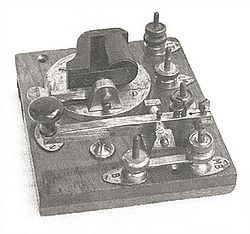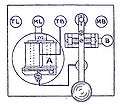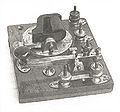Transmitter, vibrating
| Transmitter, vibrating | |
|---|---|
 |
Description[1]
When the switch of the hand telephone connected to the "Transmitter, vibrating," is pressed, a circuit is completed round the coil, through the microphone and two cells. Speaking into the microphone then produces variations in the current in the usual way, these variations are communicated to the current in the line, and speech is reproduced in a receiver introduced elsewhere in the line, though not quite so efficiently as with an ordinary telephone. It is immaterial which of the terminals marked "L" is connected to line and which to earth.
The magnet cores are composed of split tubes of soft iron, packed with charcoal iron wire. The yoke is of soft iron, secured to the cores by two No. 4 B.A. iron screws. The bobbins are formed by fixing ebonite cheeks to the ends of the cores, the latter being insulated with paper and shellac varnish. The coils are wound with double silk covered copper wire, •0108 inch in diameter (No. 32 S.W.G.), soaked in paraffin before winding. The coils are wound so as to produce opposite poles at the free ends of the magnet limbs. Each bobbin is wound to a resistance of 20 ohms ; the inner ends are soldered to the cores, and the outer ends are led to the terminal marked " T.B." ; the two coils are thus connected in parallel and have a combined resistance of 10 ohms. The coils are jacketed with sheet ebonite. The armature is of spring steel with a brass block fixed at the free end. The contacts are platinum. Two adjusting pins are provided, which, when not in use, are screwed into holes provided in the base. The knob of the key can be removed and screwed into the base, for convenience of packing. The instrument, when properly adjusted, should produce a sharp and distinct sound when a current from one Leclanche cell (resistance 2 ohms) is passed through the coils, and should work without change of adjustment with a current from 10 such cells.
Related Pages
- No related pages at this time




